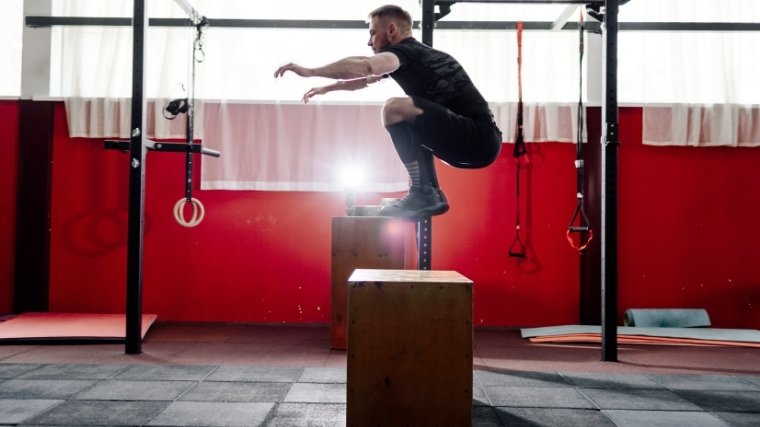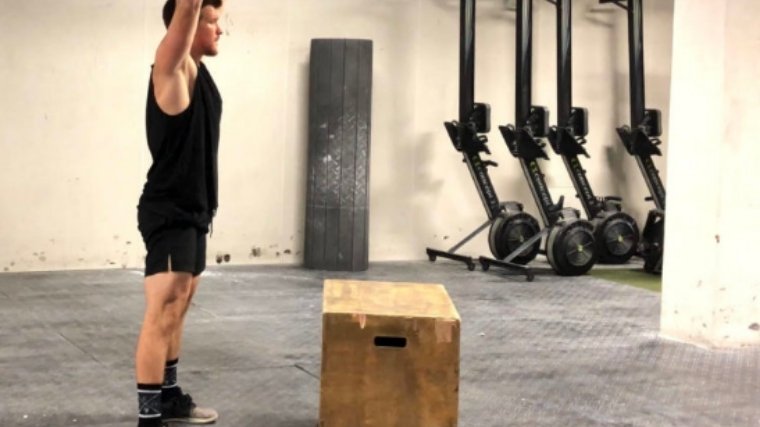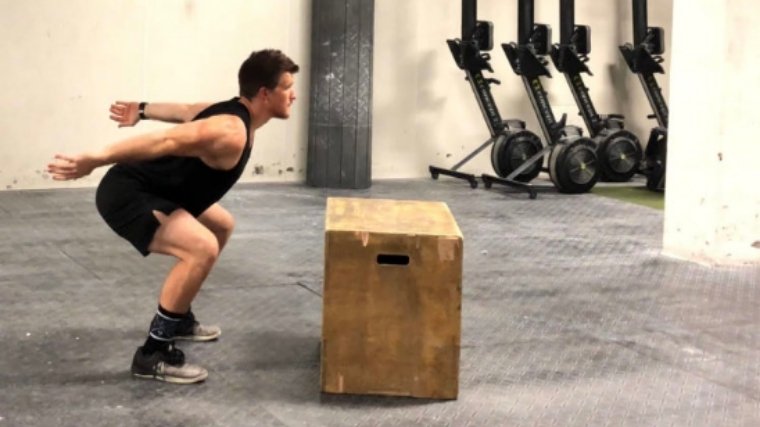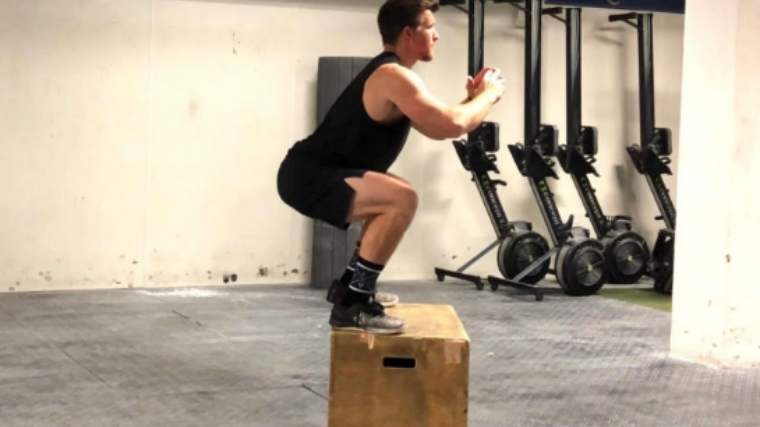Add the Box Jump to Your Routine to Power Up
Strength is ever-important, but power — defined as how quickly you can move weight — is the show. It doesn’t matter how much weight you can support on your back if you can’t move it with gusto. More power means an enhanced ability to lift more weight more quickly, and, over time, that’ll translate to more weight on the barbell. Building power requires the right exercises, and the box jump is one of the best moves to build (and test) your lower-body power output.
This plyometric exercise has the lifter jump from the ground to a box, with the goal to jump on a taller box eventually. For reference, JJ Watt, the defensive end for the Arizona Cardinals known for his strength and power, has hit a 61-inch box jump. We can’t guarantee you’ll post the same numbers, but the box jump will grant you more power to apply to your other leg exercises. Plus, you’ll look way cool doing it.
- How to Do the Box Jump
- Box Jump Sets and Reps
- Common Box Jump Mistakes
- Box Jump Row Variations
- Box Jump Row Alternatives
- Muscles Worked by the Box Jump
- Benefits of the Box Jump
- Who Should Do the Box Jump
- Frequently Asked Questions
Editor’s note: The content on BarBend is meant to be informative in nature, but it shouldn’t take the place of advice and/or supervision from a medical professional. The opinions and articles on this site are not intended for use as diagnosis, prevention, and/or treatment of health problems. Speak with your physician if you have any concerns.
How to Do the Box Jump
Here’s the right way to do a box jump. Remember, you want to be nimble and light on your feet. Don’t try and force a jump to a box height you’re not yet ready for.
Step 1 — Assume a Strong Takeoff Position
Find a box and stand facing it, about six inches away. Start with the feet about hip-width so that your ankles, knees, and hips are nearly stacked above one another. Swing your arms up.
Form Tip: A good rule of thumb is to set your feet a couple of inches closer together than you’d stand for a back squat.
Step 2 — Load the Hips and Jump
With the feet planted, the lifter should swing the arms towards the heels and drive the hips back to load your hamstrings and glutes. Once you feel a big stretch in your hamstrings and glutes, they should extend your ankles, knees, and hips while throwing the hands up to increase momentum further and leave the ground.
Form Tip: The load to jump should be one smooth motion. Try not to segment this movement. Otherwise, you’ll lose power, and your jump may fall flat.
Step 3 — Land Softly
Upon landing on the box, your ankles, knees, and hips should be flexed to allow the muscles to absorb the body weight and force. Land in a squat position and then stand up.
Form Tip: You want to appear to float right above the box, landing so that your entire foot is on the surface.
Box Jump Sets and Reps
There’s more to box jumps than grabbing a box and hopping aboard. Just like barbell work, you have to program them to suit your needs and how they fit into your training session. You won’t be using this move to build max strength — though the power you develop will help with carryover into your barbell lifts. Instead, program box jumps according to power, endurance, and skills training.
- For Technique: Perform three to four sets of three to five repetitions, resting two minutes between sets. Use a relatively low box to start.
- For Power: Start with three to five sets of one to three repetitions, resting two to three minutes between sets. Use a higher box than you would for endurance training.
- For Endurance: Do two to three sets of 10 to 20 repetitions, resting 60 to 90 seconds between.
When you’re training for endurance, find a literal middle ground with your box height. You’ll want it to be taller than what you use while focusing strictly on technique. It’ll also be lower than what you’ll use when you’re focusing on power.
Common Box Jump Mistakes
With an exercise as common as the box jump, it’s easy to hop onto the band wagon and assume you’re doing it right. But even with exercises that you see people perform all the time, you’ve got to make sure your form is locked in. Here are the most common mistakes to avoid when you’re training the box jump.
Landing Too Hard
The first thing you need to master with box jumps is the art of landing. Allow your knees to bend generously, and let your ankles and hips also flex as you land. That way, your feet won’t be absorbing all the shock of your bodyweight. If you feel the shock of landing reverberating in your body — starting with your feet — or feel pain in your heels during or after performing this move, you’re likely landing too hard. You’ll likely want to reasses your joint health first, then refine your form before attempting this exercise again.
Box Size
Just because you can hop onto a 40-inch box doesn’t mean you always should. When you’re training for power, you’ll use a higher box than you will when you’re training for endurance. That said, you’ll keep your reps low. If you need to psych yourself up significantly between each rep to achieve the height you need, you’re probably jumping too high for endurance training.
To spare your joints, instead of upping the intensity by going even higher, try adding a bodyweight move in between jumps. A common way to do this in CrossFit is to add a burpee between reps. That way, you’ll be keeping your intensity high without tearing up your knees and feet.
Doing Too Many
Yes, there is such a thing as doing too many box jumps. It might be tempting to pile on the volume since this is an unweighted move. And sure, sometimes you have to perform a solid amount of reps to complete your WOD (workout of the day). First and foremost with box jumps, you want to make sure you’re taking care of your joints.
Keep your volume relatively low — at around 20 reps per set and 60 reps total at the higher end of your workload. This will help your knees and feet have adequate recovery time and relief from the repetitive stress of this exercise. The higher you get in terms of volume, the harder it will be to keep the perfect form that helps you land softly. And the harder you land, the tougher this is on your joints.
Box Jump Variations
Below are three box jump variations that can be used to keep training varied and progressive.
Seated Box Jump
The athlete starts from a seated position and then explodes up to a box jump. This variation increases concentric power output since the person jumping can’t load up ahead of time.
This is a tough variation, so make sure you’ve mastered the art of the regular box jump before attempting this one.
One-Step Box Jump
The one-step approach to a box jump (rather than starting from a standing position) can help individuals who may need to increase your jumping ability for sport-specific purposes.
This also allows an athlete to gain momentum as they go into the jump, often increasing the height one can reach.
Single-Leg Box Jump
As the name implies, this is a box jump off of one leg. This variation is hard to do and requires a lot of balance and proprioception.
However, the payoff is increased unilateral strength, power, and balance.
Box Jump Alternatives
No box? No problem. You can improve lower body power without access to a plyo box with some box jump alternatives.
Step Up
If you don’t have access to a plyo box, you may still have a stable weight bench, a step up platform, or even a step on a stairwell. Or perhaps you’re not able to jump because your knee and/or foot health doesn’t allow it.
Whatever your situation, you can perform step ups to give yourself some of the benefits of box jumps. Your legs will get stronger and more balanced. You’ll be working unilaterally, too, which means that you’ll fight imbalances between sides. That’s always a good recipe for lower body stability and strength.
Squat Jump
The squat jump is a plyometric movement that can increase the load used (often light loads) to induce greater muscle activation and power output.
This is common in most Olympic weightlifting and formal sports programs during power and explosive phases of training.
Broad Jump
The broad jump is a plyometric movement that has the athlete jump in a more horizontal trajectory. So the hip flexion is increased (to drive the body forward), and the knee extension is decreased (since less height is needed).
Therefore, your hamstrings and hips are slightly more involved, directly applying to running and sprinting.
Muscles Worked by the Box Jump
The below muscle groups are targeted with box jumps. Note that box jumps do not necessarily increase muscle hypertrophy or strength in and of themselves. Instead, they’re used as a plyometric exercise to increase your lower body’s explosiveness and power output.

Hamstrings
Your hamstrings are one of the primary muscles involved in the box jump, as they flex your knees. Make sure they’re thoroughly warmed up before your session.
Quadriceps
Like your hamstrings, your quadriceps are involved in the force output necessary for the box jump, as they promote knee extension that propels your body upwards away from the floor.
Glutes
Your glutes are responsible for powerful hip extension and supporting your hamstrings and quadriceps in forceful lower body joint extension.
Calves
Your calves are responsible for ankle plantarflexion. Strong, stable, and powerful calves can increase stability and help lifters reach a more force triple extension in most explosive movements.
Benefits of the Box Jump
Even if you’re primarily interested in brute strength, training for power in the offseason can be a huge boon for your performance.
Increase Rate of Force Production
Increased force production can come from various methods, such as building stronger legs with squats, deadlifts, and other forms of resistance training. However, in most sports, such as weightlifting, strongman, CrossFit, and more traditional athletics, the ability to promote force at increasing rates is a key indicator of athletic potential.
Box jumps can be used to increase athletic potential, increase lower body explosiveness, and have direct carry over to other forms of jumping, squatting, deadlifting, sprinting, and weightlifting.
Improved Proprioception
Proprioception is one’s ability to control one’s body in space without even seeing your limbs. Think about an Olympic wrestler defending a takedown — their legs are sprawled out, their arms are hooked over their opponents, and their head is placed on the attacker’s mid-back. It’s an involuntary reaction that requires agility, finesse, and physical awareness.
Like other plyometric movements, box jumps can help lifters establish better body awareness and control as they explode from one position to another.
Powerful Hip and Knee Extension
To get from the floor to the box, your hips and knees need to extend forcefully to drive the body’s mass. Ultimately, this builds more power in these specific areas. This added knee and hip power will help other movements that require it — such as lunges, hip thrusts, and sprints.
Who Should Do the Box Jump?
For athletes who can safely perform the box jump, it can be used in a wide range of programs. Here’s why and how this movement affects different populations.
Strength and Power Athletes
- Powerlifters and Strongmen/Strongwomen: While maximal power output may not be the highest priority for more strength-based athletes, the ability to increase power output and muscle recruitment via box jumps can aid (even a little) overall force production. This can help to increase pulling power off the floor in a heavy deadlift, produce greater hip extension in a push press, and bolster a person’s ability to accelerate through a sticking point in a squat.
- Olympic Weightlifters: Box jumps for Olympic weightlifters can increase eccentric strength, elasticity, and power output for movements like snatches and cleans & jerks. The neurological adaptations that take place from performing box jumps can be applied directly to most of the weightlifting movements.
Functional Fitness Athletes
Functional fitness athletes, such as CrossFitters, often perform box jumps during competitions. This move also jacks up your heart rate to enhance conditioning, which is a huge part of functional, day-to-day fitness.
General Population
For all the same reasons listed above, any gym-goer can benefit from box jumps. That said, please start with a low box to ensure you’re A) nailing the proper mechanics and B) aren’t risking injury.
Get the Jump on Power Training
Hefting a heavy barbell isn’t the only way to get more powerful in the gym. You can build yourself a powerful lower body — and a strong pair of lungs — with nothing but a plyo box and a lot of grit. Box jumps might not be the easiest exercise in the gym, but they’re well worth the effort. As long as you’re landing softly, you can go as hard as you want.
FAQs
Box jumps can look both simple and very difficult all at the same time — because they are. You might be grappling with figuring out how they can get you where you want to be. Check out some of the most frequently asked questions about box jumps.
How high of a box jump should I perform?
You should jump to as high of a box as possible while still maintaining solid box jump mechanics. That is an extension of your ankles, knees, and hips, and a soft landing. If you find yourself overextending or your feet sliding on the box upon landing, then lower the height.
How many sets and reps of box jumps should I do?
For max power output, stick with three to five sets of one to three reps to a high box. For endurance-focused workouts, do two to three sets of 20-plus reps to a lower box. To work on technique, choose a moderate-height box, and then perform three sets of five reps.
Should you step down or jump off a box in between reps?
It depends. If you are jumping for peak power output, then you could step down to minimize wear and tear on the body, and allow yourself to recover between reps. If you are looking for endurance (or if you need to do multiple jumps in a row for time), then maybe jumping down is an option. Note that jumping down does increase the loading and stress on your body. So if you are doing high volume box jumps, stepping down may be a better option for most people.
{"@context":"https://schema.org","@type":"FAQPage","mainEntity":[{"@type":"Question","name":"How high of a box jump should I perform?","acceptedAnswer":{"@type":"Answer","text":"
You should jump to as high of a box as possible while still maintaining solid box jump mechanics. That is an extension of your ankles, knees, and hips, and a soft landing. If you find yourself overextending or your feet sliding on the box upon landing, then lower the height.
"}},{"@type":"Question","name":"How many sets and reps of box jumps should I do?","acceptedAnswer":{"@type":"Answer","text":"
For max power output, stick with three to five sets of one to three reps to a high box. For endurance-focused workouts, do two to three sets of 20-plus reps to a lower box. To work on technique, choose a moderate-height box, and then perform three sets of five reps.
"}},{"@type":"Question","name":"Should you step down or jump off a box in between reps?","acceptedAnswer":{"@type":"Answer","text":"
It depends. If you are jumping for peak power output, then you could step down to minimize wear and tear on the body, and allow yourself to recover between reps. If you are looking for endurance (or if you need to do multiple jumps in a row for time), then maybe jumping down is an option. Note that jumping down does increase the loading and stress on your body. So if you are doing high volume box jumps, stepping down may be a better option for most people.
"}}]}
Featured image: Mirage_studio
Deja una respuesta




►Te puede interesar...